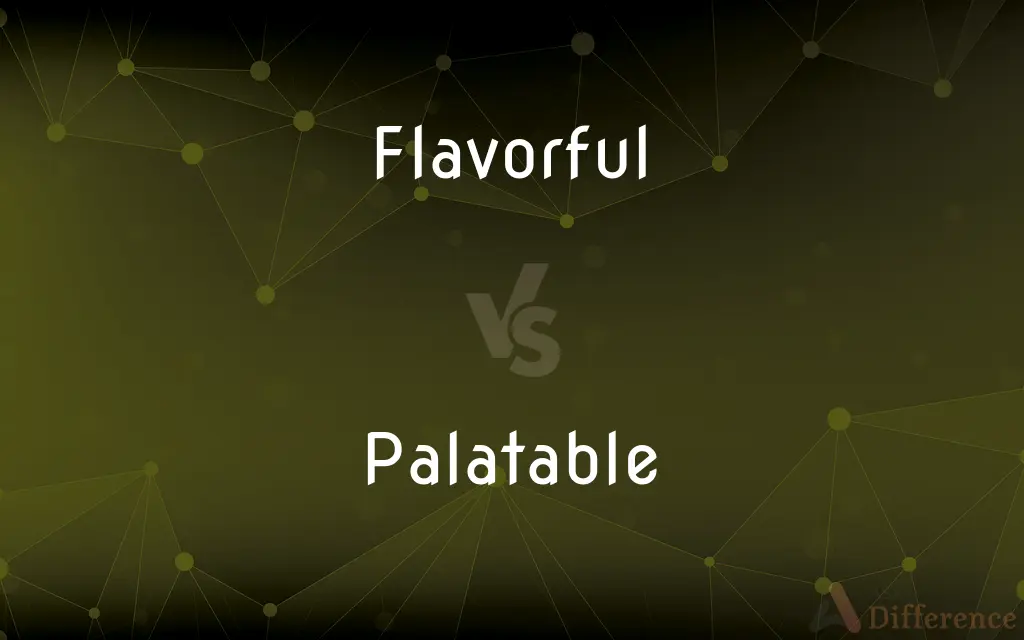Flavorful vs. Palatable — What's the Difference?
By Tayyaba Rehman & Maham Liaqat — Updated on March 20, 2024
Flavorful emphasizes rich, distinctive tastes, while palatable refers to food that's agreeably acceptable to the palate.

Difference Between Flavorful and Palatable
Table of Contents
ADVERTISEMENT
Key Differences
Flavorful describes foods or things rich in flavor, often implying a depth and complexity that makes them particularly enjoyable to taste. These flavors can be bold, subtle, intricate, or a combination, but they're always prominent and often memorable. On the other hand, palatable refers to something that is pleasant or acceptable to the taste, but not necessarily remarkable or intense in flavor. While a flavorful dish can captivate the senses and leave a lasting impression, a palatable one simply meets the basic criteria of being agreeable to eat.
Flavorful foods are often sought after for their ability to provide a sensory experience that is both unique and satisfying. They might be characterized by a blend of spices, herbs, and other ingredients that contribute to a complex taste profile. Palatable foods, while pleasant, might not possess the same complexity or intensity of flavors. They are acceptable and satisfying to most people, but they might not stand out in terms of taste.
In the context of culinary experiences, a flavorful dish is often the highlight of a meal, something that diners look forward to and remember. It's the kind of food that might be described as "mouth-watering" or "delectable." Conversely, a palatable dish serves its purpose by being enjoyable enough to eat without necessarily being the star of the show. It's the kind of food that is reliably good but not necessarily extraordinary.
For individuals with adventurous palates, flavorful foods offer an opportunity to explore different culinary traditions and ingredient combinations. These foods can evoke emotions, memories, and even a sense of place. In contrast, palatable foods are often more about comfort and familiarity. They are the safe choices on a menu, the ones that are unlikely to disappoint but also unlikely to surprise.
When it comes to personal preference, some might prioritize flavorful foods for their excitement and complexity, while others might prefer the reliability and comfort of palatable foods. This choice can depend on the occasion, the mood, and individual taste preferences. Flavorful dishes are often chosen for special occasions or when one wants to indulge, whereas palatable dishes might be the go-to for everyday meals.
ADVERTISEMENT
Comparison Chart
Definition
Rich and full of flavor
Pleasant to taste but not necessarily exciting
Intensity
Can be intense and complex
Generally mild and agreeable
Purpose
To excite the palate and offer a memorable experience
To satisfy basic taste preferences without offending
Occasion
Often sought for special meals or by those seeking culinary adventures
Preferred for everyday meals or by those with conservative taste preferences
Perception
Associated with culinary artistry and innovation
Considered reliable and safe
Compare with Definitions
Flavorful
Rich in taste and aroma.
The flavorful curry was a blend of several spices.
Palatable
Pleasant to taste but not exciting.
The soup was palatable but lacked any distinctive flavors.
Flavorful
Offering a complex taste experience.
The restaurant is known for its flavorful fusion dishes.
Palatable
Acceptable to the palate.
The meal was simple but palatable.
Flavorful
Intense and memorable in flavor.
The sauce added a flavorful punch to the dish.
Palatable
Often used to describe safe food choices.
She opted for a palatable option to avoid any risks.
Flavorful
Evoking a sensory response.
The flavorful aroma of the stew made everyone's mouth water.
Palatable
Reflecting comfort and familiarity.
The home-cooked meal was very palatable and comforting.
Flavorful
Associated with culinary creativity.
The chef's flavorful creations impressed all the guests.
Palatable
Satisfying basic taste requirements.
The cafeteria food is always clean and palatable.
Flavorful
Full of flavor; savory.
Palatable
(of food or drink) pleasant to taste
A very palatable local red wine
Flavorful
Full of flavor.
Palatable
Acceptable to the taste; sufficiently agreeable in flavor to be eaten.
Flavorful
Tasteful; having a good taste; - of food.
Palatable
Acceptable or agreeable to the mind or sensibilities
A palatable solution to the problem.
Flavorful
Full of flavor
Palatable
Pleasing to the taste, tasty.
For some instant noodles make a palatable, if not especially nutritious, meal.
Palatable
(figurative) Tolerable, acceptable.
The agreement was palatable to both of them.
Palatable
Agreeable to the palate or taste; savory; hence, acceptable; pleasing; as, palatable food; palatable advice. Opposite of unpalatable.
Palatable
Acceptable to the taste or mind;
Palatable food
A palatable solution to the problem
Common Curiosities
Can a dish be both flavorful and palatable?
Yes, a dish can be both flavorful and palatable if it has a rich and enjoyable taste that is also widely accepted as pleasant.
Is flavorful food always spicy?
No, flavorful food is not always spicy; it can be rich in any variety of tastes and aromas, not limited to heat.
Is it more challenging to cook flavorful food than palatable food?
Cooking flavorful food might require more skill and creativity in combining ingredients for depth of flavor, whereas palatable food focuses on basic taste satisfaction.
What does palatable mean?
Palatable refers to something that is pleasant or acceptable to the taste, but not necessarily remarkable or intense in flavor.
Is palatable food considered bland?
Not necessarily; palatable food is agreeable and pleasant to taste but might not have the complex or intense flavors that flavorful food has.
Can palatable foods be satisfying?
Yes, palatable foods can be satisfying as they meet basic taste preferences and are generally agreeable to most people.
Are flavorful foods preferred over palatable foods?
Preference between flavorful and palatable foods varies among individuals, depending on their taste and the occasion.
How does one's sense of taste affect the perception of flavorful and palatable foods?
Individual taste preferences and sensitivities can greatly affect how one perceives the flavor and palatability of food.
What does flavorful mean?
Flavorful refers to foods or things that are rich and full of flavor, often with a depth and complexity that makes them particularly enjoyable.
Can dietary restrictions affect the palatability of food?
Yes, dietary restrictions can limit ingredient choices, potentially affecting the palatability of food for some individuals.
Are there health considerations in choosing between flavorful and palatable foods?
Health considerations can influence choices, as some may seek flavorful foods for their potential health benefits from spices and herbs, while others might prefer palatable foods for their simplicity and digestibility.
Do all cultures value flavorful food the same way?
Cultural preferences for food vary, and while some cultures might highly value flavorful foods, others might prioritize balance, texture, or nutritional value.
Can the presentation of food affect its perceived flavor or palatability?
Yes, the presentation can influence perception, with visually appealing food often perceived as more flavorful or palatable.
How do chefs create flavorful dishes?
Chefs create flavorful dishes by combining a variety of ingredients, spices, and cooking techniques to develop depth and complexity in taste.
Can the environment or setting influence the enjoyment of flavorful versus palatable foods?
The dining environment can affect enjoyment, with certain settings enhancing the experience of flavorful foods and others making palatable foods more appealing.
Share Your Discovery

Previous Comparison
Hateful vs. Hatel
Next Comparison
Sublime vs. SublimedAuthor Spotlight
Written by
Tayyaba RehmanTayyaba Rehman is a distinguished writer, currently serving as a primary contributor to askdifference.com. As a researcher in semantics and etymology, Tayyaba's passion for the complexity of languages and their distinctions has found a perfect home on the platform. Tayyaba delves into the intricacies of language, distinguishing between commonly confused words and phrases, thereby providing clarity for readers worldwide.
Co-written by
Maham Liaqat













































